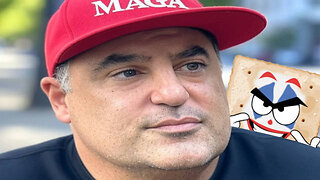Premium Only Content

German Volume Training, GVT. There is More to it Than You Think.
German Volume Training, GVT. There is More to it Than You Think.
Today we are going to talk about a very popular training program, and that is German Volume Training or GVT for short. Similar versions of this program have been around since the 1950's with Vince Gironda having a similar type program. But it was Charles Poliquin that popularized it in the 1990’s and while there have been many spin offs Charles’s remains the most popular and the one we will be looking at today. The goal for this program is to build lean muscle mass at an accelerated rate.
If you are interested in losing body fat and adding muscle, please email me at 1shark1bite@gmail.com for information on my personal training services.
Facebook; https://www.facebook.com/Fit-and-50-548844435514900/
My Amazon page link; https://www.amazon.com/shop/fitand50
My Affiliate link to Lebert for their Equalizer bars and more; http://www.easywebautomation.com/app/?af=1679568 and use the discount code LFI20 you will receive 20 dollars off your purchase
The first thing I would like to note, is it isn’t just one workout but part of a phased program. GVT is actually 3 phases, plus a 3 week recovery block just after phase one. The first phase is talked about the most as it has the ten sets of ten reps on the first two exercises. There are four exercises per workout and 3 different workouts that repeat every 5 days.
All of the programs I design for myself and my clients are phased varying the reps, number of sets and weight, to keep the program fresh with my clients progressing. German volume training Adjusts the weight and number of reps with the same goal in mind.
The first workout of the 5 day training block, supersets chest and back. A superset is where you do two exercises back to back with little to no rest in between. In this case you would do 10 reps of chest with say flat bench then go straight to bent over rows to do another 10 reps, then rest for 90 to 120 secs before starting your next set. Another option here, would be chest dips superset with pull-ups, this is a favorite combination of mine.
For these first two exercises you should always pick compound movements, the more muscles the exercise uses, the better. And always do the same exercise for all ten sets. The next two exercises are supplementary for these you only do 3 sets of 10 to 20 reps with 60 seconds rest. So these would be exercises like chest flys and lat pull downs. I might even do a dumbbell pullover here.
Before we go into the next workout we should talk about tempo and weight selection. We are given two different ways to select the weight we use either 60% of our one rep max or find the weigh that we hit technical failure on at our 20th rep and use that weight for the 10 reps. It might feel light at first, but by the tenth set you may not even be able to finish all ten reps. Now if you can finish all the reps without taking any extra rest then it is time to increase the weight. You do this in 4 to 5% increments. Keeping strict watch on your rest times as this is a Key part of this program. So, it is recommended you use a stop watch.
This incremental increase in weight makes this program progressive which is one of the things I like about GVT.
You might think the weight is too light to build muscle, but just a couple of weeks ago we looked at a study that showed older men who were lifting similar weight and reps, although less sets, were able to build muscle. And Canadian weightlifter and Olympic silver medalist Jacque Demers credits The size of his thighs to GVT.
The programs tempo is a 4 second negative, which is when you lower the weight and a 2 second concentric which is the push or pull portion of the movement. A little slow for my liking, but you can definitely see how it adds to the intensity.
Day 2 is legs and abs, the 10 x 10 superset most commonly used is squats and leg curls. For supplementary work you do an ab exercise like hanging leg raises or maybe a cable crunch and for our calves we have calf raises, either seated or standing.
Day 3 is a rest day, and day 4 is arms and shoulders pairing a move like close grip bench press or Tricep dips with a curl variation like the barbell curls or hammer curls. The accessory work would be for the shoulders. Dumbbell lateral raises and rear delt flys make sense here.
Day 5 is a rest day.
On day 6 the entire sequence begins again and is repeated 6 times which will take a month. Then before you move into phase 2 it is recommended that you back off a bit and do only 4 to 6 sets with and average of 6 to 8 reps per set. This is a recovery period meant to be 3 weeks long.
In Phase 2 the weight goes up and the reps drop to 6, still ten sets though. The weight you use is the same as the maximum amount of weight you can do for 12 reps to failure. It is the same as the first phase although you can choose different exercises in this phase from the first.
-
 4:53
4:53
Fit and 50
1 year ago $0.07 earnedHow to Speed Up Muscle Recovery Over 50 (Recover Like a 20 yr old)
5084 -
 LIVE
LIVE
Wendy Bell Radio
6 hours agoNothing To See Here
10,830 watching -
 2:12:18
2:12:18
TheDozenPodcast
22 hours agoIslam vs Christianity: Bob of Speakers' Corner
55.7K15 -
 14:36
14:36
The StoneZONE with Roger Stone
1 day agoRoger Stone Delivers Riveting Speech at Turning Point’s AMFEST 2024 | FULL SPEECH
72.4K23 -
 18:59
18:59
Fit'n Fire
12 hours ago $5.13 earnedZenith ZF5 The Best MP5 Clone available
35.5K1 -
 58:34
58:34
Rethinking the Dollar
21 hours agoTrump Faces 'Big Mess' Ahead | RTD News Update
31.2K5 -
 5:35
5:35
Dermatologist Dr. Dustin Portela
21 hours ago $1.63 earnedUnboxing Neutrogena PR Box: Skincare Products and Surprises!
24.5K3 -
 11:20
11:20
China Uncensored
20 hours agoCan the US Exploit a Rift Between China and Russia?
54.2K20 -
 2:08:48
2:08:48
TheSaltyCracker
15 hours agoLefty Grifters Go MAGA ReeEEeE Stream 12-22-24
251K695 -
 1:15:40
1:15:40
Man in America
18 hours agoThe DISTURBING Truth: How Seed Oils, the Vatican, and Procter & Gamble Are Connected w/ Dan Lyons
147K133